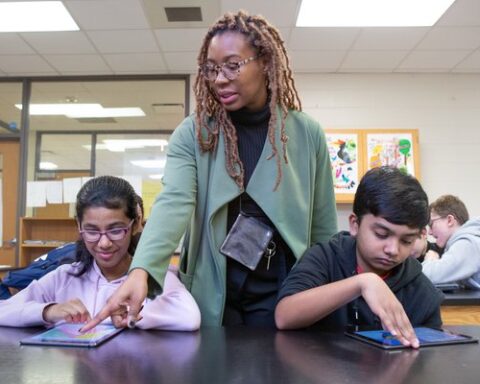By Andrew Cohen
As part of an effort across The Texas A&M University System to encourage students toward the teaching profession, chapters of the Texas Association of Future Educators (TAFE — pronounced “taffy”) have begun to spring up statewide. At Prairie View A&M University, the new TAFE chapter has both sprung up and sprang into action.
Advised by Katina L. Thomas, Ed.D, an assistant professor in the Whitlowe R. Green College of Education, PVAMU’s TAFE chapter meets weekly over Zoom. Its inaugural president, senior Joy Houston, says the group is focused on several key areas.
“We’ve already talked to PV education alums who are now teachers and administrators about coming back to talk with current students about their experiences,” Houston said. “We also want to interact and engage with the Waller/Prairie View/Hempstead school community, so we’re looking into partnering with them on some volunteer opportunities.”
The chapter’s primary focus is addressing the nation’s teacher shortage and the underrepresentation of minorities in teaching and administrative roles. Teacher shortages, Thomas noted, “have skyrocketed across the board since the pandemic. And there is such a low number of teachers of color, in general. It’s alarming. Over 80% of the teachers in this country are white and female. We have to make sure we get as many teachers who look like us in the classroom, and we understand the pipeline starts early.”
TAFE is primarily a secondary school organization that welcomes collegiate chapters from around the state. It works in tandem with Educators Rising, its national, college-level equivalent. Both organizations run competitions where future educators write sample lesson plans, map out the use of classroom visual aids, etc. Both focus on teacher preparation as integral to teacher recruitment — giving middle, high school and college students a clearer view of the profession. Overall, helping these students make a successful transition to the classroom can aid in the recruitment and retention of teachers.
“One of our goals is not only teacher preparation but also professional development beyond the classroom to help our future teachers of color become familiar with what’s going to happen in their professional life,” Thomas said.
Of the newest recruits to education, Thomas added, “They’re sold on it, but what we’re discovering is that a lot of them hunger for the extracurricular activities where they can go back out into the community so that everybody benefits. They want that community exposure, as well as community involvement. Teaching is more than going into your classroom and closing the door. We want to make sure they know that teaching is a service. You’re called to teach. It involves more than building your lesson; it involves building relationships.”
Thomas said she “stumbled into” TAFE through the collaboration between Phi Beta Kappa, of which she is a member, and Educators Rising. Houston’s experience was the opposite. She was an officer in the TAFE chapter at Cy-Fair High School in Cypress, Texas, starting as the social interactions chair and then becoming vice president in her senior year. “In high school, we did observations in the elementary and middle schools next to Cy-Fair — basically, student teaching,” Houston said. “We also took part in TAFE competitions; one of my classmates and I won a state title by creating an interactive game. We volunteered as well.”
The debut of a TAFE chapter at PVAMU is icing on the cake for someone like Houston. “I was intrigued and glad,” she said. “With our collegiate chapter, we’re just trying to expose and interest our college students in more of the things that come with teaching. Our purpose is to get them doing these things and collaborate with others because the best way to learn it is to be as hands-on as possible.”
“I’m hoping that with the students we have right now and the ones who will follow, even after I graduate and give my title to someone else, we can motivate more minority college students to become educators. I feel students always do better when they have teachers who look like them and are motivated like them.”




